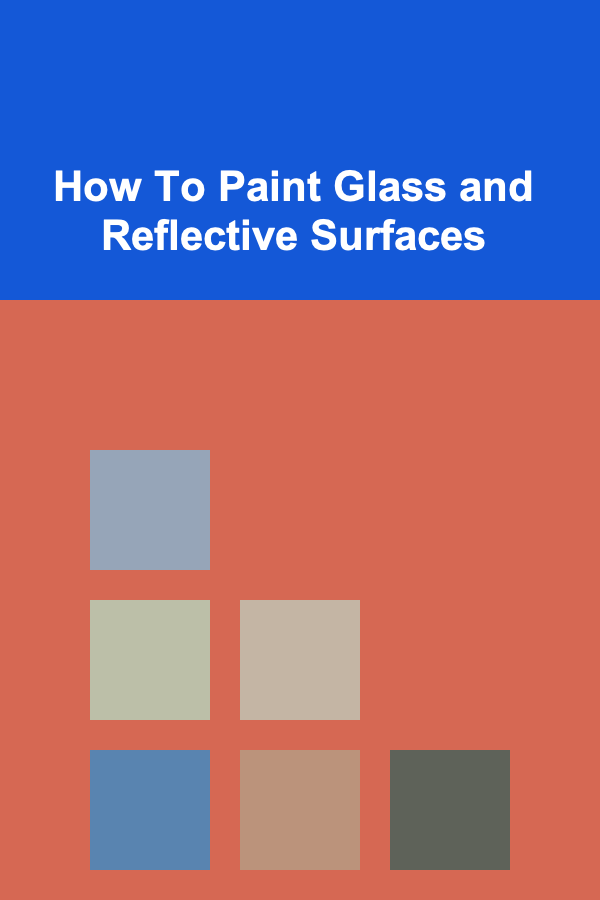
How To Paint Glass and Reflective Surfaces
ebook include PDF & Audio bundle (Micro Guide)
$12.99$10.99
Limited Time Offer! Order within the next:

Painting glass and reflective surfaces can be a rewarding challenge for both professional artists and DIY enthusiasts. Glass surfaces, due to their unique characteristics, require special techniques and materials to achieve a lasting and visually appealing finish. Reflective surfaces, on the other hand, pose an additional challenge, as they reflect light and their surface properties are often different from standard painting surfaces like wood, canvas, or walls.
This guide will walk you through the process of painting glass and reflective surfaces, from preparation to finishing, and will discuss the different types of paints, tools, and methods that can help you achieve the best results.
Understanding Glass and Reflective Surfaces
Before jumping into the actual process of painting, it's important to understand the nature of glass and reflective surfaces. Glass, by its nature, is smooth, non-porous, and often slippery, which can make it difficult for paint to adhere properly. Reflective surfaces, such as mirrors or highly polished metals, reflect light and require a specific approach to ensure that the paint bonds correctly and doesn't peel off easily.
Key Characteristics of Glass
- Smooth Surface: Glass is smooth, and without proper preparation, paint will not adhere well.
- Non-porous: Glass does not absorb paint like porous surfaces such as wood, which can make it harder to get an even application.
- Reflective: Glass reflects light, which can interfere with the final appearance of your painted design.
Key Characteristics of Reflective Surfaces
- Mirror-like Finish: Highly reflective surfaces like mirrors and polished metal reflect nearly all light that hits them.
- Slippery Surface: These surfaces are typically coated with a protective layer that makes them less receptive to paint.
- Durability Issues: Reflective surfaces may wear down paint more quickly due to their exposure to frequent use or environmental factors.
Choosing the Right Paint
Selecting the right paint for glass and reflective surfaces is critical to achieving a durable and aesthetically pleasing result. Here are the best types of paint for glass and reflective surfaces:
2.1 Acrylic Paints
Acrylic paints are a popular choice for painting glass because they dry quickly and are easy to work with. However, not all acrylic paints are suitable for glass, so it's essential to choose a paint specifically designed for non-porous surfaces. These paints are usually labeled "for glass" or "multi-surface."
- Advantages: Fast-drying, water-based, available in many colors, easy cleanup with water.
- Disadvantages: May require a primer for proper adhesion and may not be as durable without sealing.
2.2 Enamel Paints
Enamel paints are a more durable option for glass surfaces. They are oil-based, making them ideal for painting glass and reflective surfaces, as they tend to be more resilient against wear and tear.
- Advantages: Durable, resistant to chipping, available in glossy and matte finishes.
- Disadvantages: Longer drying time, more difficult cleanup (requires solvents like turpentine).
2.3 Spray Paint
Spray paints specifically formulated for glass and reflective surfaces are convenient and easy to apply. They can cover large areas evenly and provide a smooth, consistent finish.
- Advantages: Quick application, smooth finish, available in various finishes.
- Disadvantages: Requires ventilation and masking off areas to avoid overspray, can be difficult to control.
2.4 Specialty Paints for Reflective Surfaces
For reflective surfaces such as mirrors or polished metals, there are specialty paints available that are designed to adhere to these difficult surfaces. These paints often include a bonding agent that helps them grip the smooth, shiny surface.
- Advantages: Excellent adhesion, high durability, formulated for specific reflective surfaces.
- Disadvantages: Can be expensive, may require special techniques or tools.
Preparing the Surface
Proper surface preparation is the most critical step in painting glass or reflective surfaces. Without adequate preparation, the paint may peel off or not adhere properly. Here's how to prepare the surfaces for painting:
3.1 Cleaning the Surface
The first step in preparing any surface for painting is cleaning it thoroughly. Dust, dirt, and grease can prevent paint from sticking to the surface.
- Use a glass cleaner: For glass surfaces, use a standard glass cleaner to remove any fingerprints, dust, or grease. Wipe the surface clean with a lint-free cloth.
- Use rubbing alcohol for reflective surfaces: For mirrors or polished metals, use rubbing alcohol on a cloth to remove oils and fingerprints. This is particularly important for reflective surfaces that tend to accumulate oils from skin contact.
3.2 Sanding the Surface (Optional)
Sanding can help provide texture and improve paint adhesion. While not always necessary, this step can make a significant difference, especially for non-porous or highly polished surfaces.
- Lightly sand glass: If you're painting glass, lightly sand the surface using fine-grit sandpaper (around 220-grit). This creates small scratches in the surface, allowing the paint to grip better.
- Sand reflective surfaces: For mirrors or polished metal, you can lightly sand the surface with fine-grit sandpaper. Be cautious not to damage the reflective coating.
3.3 Using a Primer
While some paints are formulated to stick directly to glass and reflective surfaces, others may require a primer. A good primer helps the paint adhere better and improves durability.
- Choose a primer for glass: Look for a primer that is specifically made for glass or non-porous surfaces. These primers create a bond that allows the paint to adhere.
- Use an adhesive primer for reflective surfaces: If you're painting a mirror or metal, an adhesive primer is often required to ensure that the paint sticks to the smooth surface.
Painting the Surface
Now that the surface is prepared, it's time to apply the paint. The method you use will depend on the type of paint you're using and the surface you're painting.
4.1 Applying Paint to Glass
4.1.1 Using Acrylic Paints
For acrylic paints, apply the paint in thin, even layers. Using a small brush or foam brush, start painting in one direction, and avoid overloading the brush to prevent streaking. You may need to apply two to three coats of paint for an even finish.
4.1.2 Using Enamel Paints
Enamel paints can be applied in a similar manner to acrylic paints, but keep in mind that they take longer to dry. Allow each coat to dry fully before applying the next coat. Enamel paints also tend to have a smoother finish, so it's important to apply thin layers to avoid drips or bubbles.
4.2 Applying Paint to Reflective Surfaces
4.2.1 Using Specialty Paints
If you're using specialty paints designed for reflective surfaces, follow the manufacturer's instructions carefully. Apply the paint in thin layers, allowing each layer to dry before applying the next.
4.2.2 Using Spray Paint
Spray paint is a great option for reflective surfaces because it provides an even, smooth coat. Hold the can about 8--12 inches away from the surface and spray in light, sweeping motions. Allow the paint to dry between coats, and apply additional layers until you achieve the desired coverage.
Finishing and Sealing
Once the paint has dried and you've achieved the desired finish, it's time to seal and protect your work. Sealing the paint helps protect it from scratches, stains, and wear.
5.1 Using a Clear Sealer
A clear acrylic sealer can be applied to both glass and reflective surfaces to protect the paint and give it a glossy finish. Be sure to choose a sealer that is compatible with the paint you've used (e.g., an enamel sealer for enamel paint or an acrylic sealer for acrylic paint).
5.2 Curing the Paint
For enamel or other oil-based paints, allow the paint to cure for several days before using or handling the painted object. This ensures that the paint hardens completely and provides the best durability.
5.3 Avoiding Over-Scrubbing
While your paint may be durable, it's important to avoid excessive scrubbing or harsh chemicals on the painted surface. Gentle cleaning with a soft cloth is usually sufficient to maintain the appearance of the paint.
Troubleshooting Common Issues
Painting glass and reflective surfaces can present some challenges. Here are some common issues and how to address them:
6.1 Paint Peeling or Cracking
If the paint starts to peel or crack, it could be due to improper surface preparation or incompatible paint types. Be sure to clean the surface thoroughly, use the right primer, and choose the appropriate paint for the surface.
6.2 Uneven Coverage
Uneven coverage can occur if the paint is applied too thickly or if the surface is not prepped properly. To fix this, sand the surface lightly and apply thinner layers of paint.
6.3 Drips or Bubbles
Drips or bubbles can happen when too much paint is applied at once. To fix this, gently sand the area once it's dry and apply a thin coat of paint.
Conclusion
Painting glass and reflective surfaces is a rewarding project that requires the right materials, tools, and techniques. By following the steps outlined above, you can transform glass or reflective surfaces into beautiful, customized pieces of art or functional decor. The key to success lies in proper surface preparation, choosing the right paint, and applying it carefully for a smooth, durable finish. Whether you're painting a glass vase, a mirror, or a metal object, these tips will help you achieve stunning results.

10 Easy DIY Children's Toys and Games That Spark Imagination
Read More
How to Clean and Maintain Your Home's Kitchen Exhaust Fan
Read More
How to Customize Meal Prep According to Family Preferences
Read More
How to Set Up a Jewelry Repair Station at Home
Read More
Why Organizing Your Cleaning Supplies Can Make Chores Easier
Read More
Mastering Delegation for Busy Leaders: A Comprehensive Guide
Read MoreOther Products

10 Easy DIY Children's Toys and Games That Spark Imagination
Read More
How to Clean and Maintain Your Home's Kitchen Exhaust Fan
Read More
How to Customize Meal Prep According to Family Preferences
Read More
How to Set Up a Jewelry Repair Station at Home
Read More
Why Organizing Your Cleaning Supplies Can Make Chores Easier
Read More